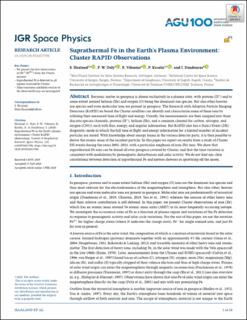| dc.contributor.author | Haaland, Stein | |
| dc.contributor.author | Daly, Patrick W. | |
| dc.contributor.author | Vilenius, Esa | |
| dc.contributor.author | Krcelic, Patrik | |
| dc.contributor.author | Dandouras, Iannis | |
| dc.date.accessioned | 2021-05-10T12:06:27Z | |
| dc.date.available | 2021-05-10T12:06:27Z | |
| dc.date.created | 2020-11-18T09:48:33Z | |
| dc.date.issued | 2020 | |
| dc.identifier.issn | 2169-9380 | |
| dc.identifier.uri | https://hdl.handle.net/11250/2754669 | |
| dc.description.abstract | Baryonic matter in geospace is almost exclusively in a plasma state, with protons (H +) and to some extent ionized helium (He) and oxygen (O) being the dominant ion species. But also other heavier ion species and even molecular ions are present in geospace. The Research with Adaptive Particle Imaging Detectors (RAPID) on board the Cluster satellites can identify and characterize some of these ions by utilizing their measured time of flight and energy. Usually, the measurements are then assigned into three discrete species channels; protons (H +), helium (He), and a common channel for carbon, nitrogen, and oxygen (CNO), each with flux, energy, and angular information. But RAPID also has a Direct Event (DE) diagnostic mode in which the full time of flight and energy information for a limited number of incident particles are stored. With knowledge about energy losses in the various detector parts, it is then possible to derive the atomic mass of the incident particle. In this paper we report on results from a study of Cluster DE events during the years 2001–2018, with a particular emphasis of iron (Fe) ions. We show that suprathermal Fe ions can be found all over geospace covered by Cluster, and that the time variation is consistent with modulation by geomagnetic disturbances and solar activity. We do not find any clear correlations between detection of suprathermal Fe and meteor showers or sputtering off the moon. | en_US |
| dc.language.iso | eng | en_US |
| dc.publisher | American Geophysical Union | en_US |
| dc.rights | Navngivelse 4.0 Internasjonal | * |
| dc.rights.uri | http://creativecommons.org/licenses/by/4.0/deed.no | * |
| dc.title | Suprathermal Fe in the Earth's Plasma Environment: Cluster RAPID Observations | en_US |
| dc.type | Journal article | en_US |
| dc.type | Peer reviewed | en_US |
| dc.description.version | publishedVersion | en_US |
| dc.rights.holder | Copyright 2020 the authors. | en_US |
| dc.source.articlenumber | e2019JA027596 | en_US |
| cristin.ispublished | true | |
| cristin.fulltext | original | |
| cristin.qualitycode | 2 | |
| dc.identifier.doi | 10.1029/2019JA027596 | |
| dc.identifier.cristin | 1849080 | |
| dc.source.journal | Journal of Geophysical Research (JGR): Space Physics | en_US |
| dc.source.40 | 125 | |
| dc.identifier.citation | Journal of Geophysical Research (JGR): Space Physics. 2020, 125 (2), e2019JA027596. | en_US |
| dc.source.volume | 125 | en_US |
| dc.source.issue | 2 | en_US |

